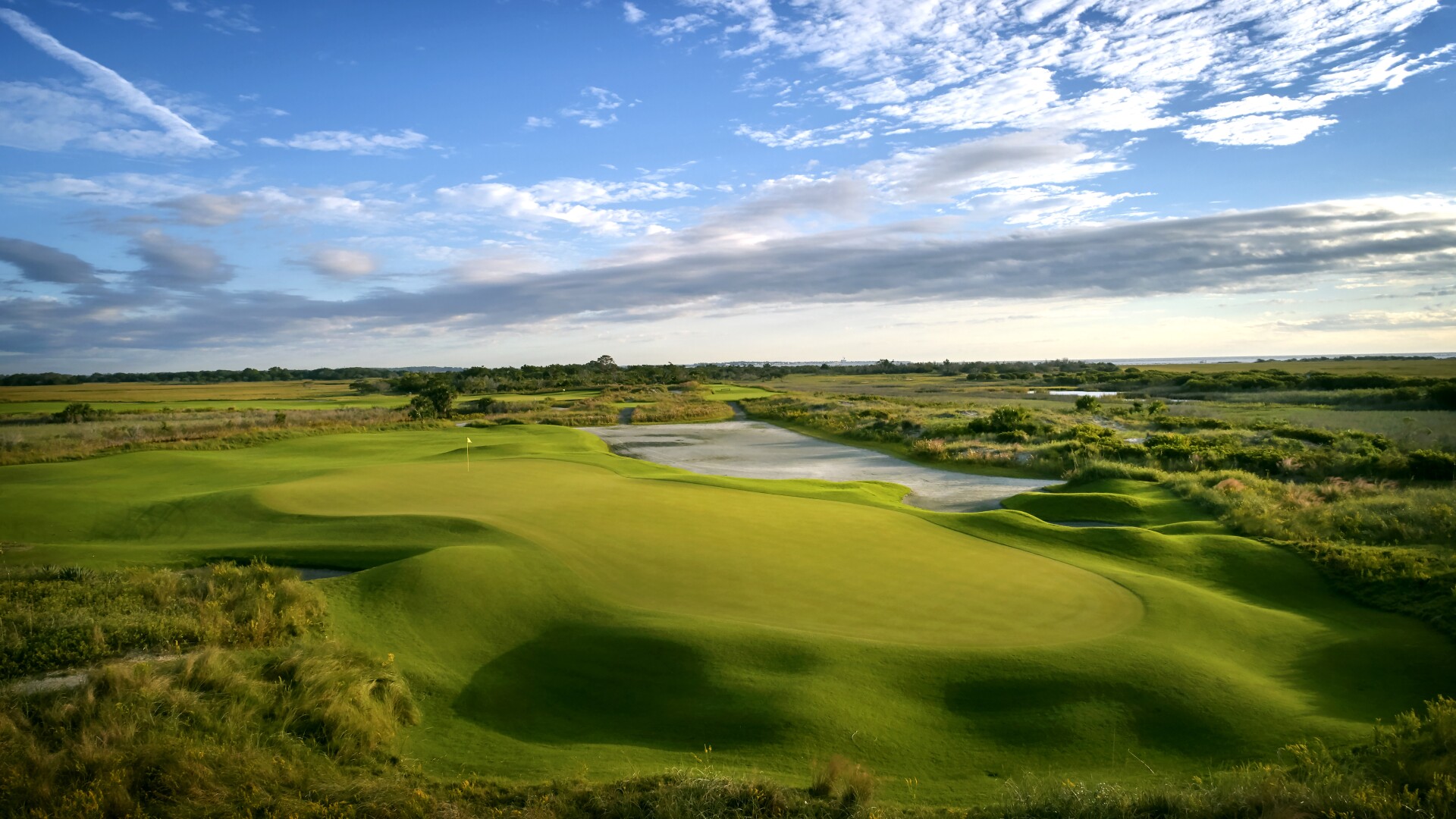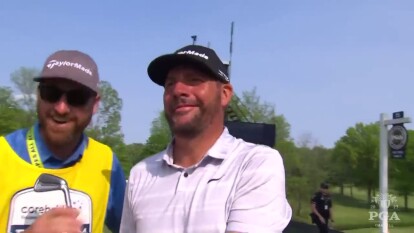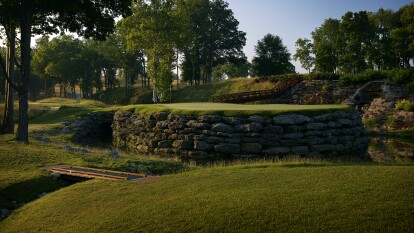It’s nothing new for the Ocean Course at Kiawah Island Golf Resort to be in the golf world’s spotlight. Site of the breathtaking 1991 Ryder Cup and Rory McIlroy’s victory in the 2012 PGA Championship, the Ocean Course ranks No. 13 in the United States on Golfweek’s Best list for Modern Courses and is the No. 1 public-access track in South Carolina.
Fans of golf watching on TV likely are familiar with the seaside links built by Pete Dye with help from his wife, Alice. But how does the course play when it’s not hosting a major? The course has seen nearly 11,000 days of resort play since that Ryder Cup ended with a narrow U.S. victory over the Europeans, and for most of those the course has been set up to accommodate amateurs instead of challenging the best players in the world.
For those resort guests in day-to-day play, there’s generally a bit less roll in the fairways, the greens are a bit more accepting and the pins are much easier than the pros see. Other than that, it’s the same golf course and provides one of the great opportunities in U.S.-based golf for regular players to test themselves on public-access championship courses.
With the Ocean Course again hosting a major with this year’s PGA Championship on May 20-23, the layout must again transition from resort players to the pros. And Jeff Stone is in charge of making that happen.
Stone has worked at Kiawah Island Golf Resort since before that 1991 Ryder Cup, transitioning from roles as head superintendent at the resort’s Cougar Point and Turtle Point courses before taking over the lead job at the Ocean Course in 2003. He has seen the Ocean Course in any conceivable condition, and it’s his job to make sure the layout is primed for this year’s PGA Championship.
After playing a round in late 2020 and seeing first-hand the incredible condition the course already was in, I spoke with Stone in January about the massive amount of planning and work that goes into taking a course from resort play to a major championship, and all the benefits and challenges the Ocean Course offers.
Golfweek: You’re getting close to another major. In general, how’s it all going?
Stone: It’s going good. Weather is starting to change a little bit, and February is coming up, so we’re starting to get into some days at 32 degrees and some days at 72 degrees.
We’re getting to the point now where we’ve really started buckling down on the detail work, you know, to really see where our grass is, just getting it really dialed in. Focused on getting things ready. We are still a little over four months out, so it’s time to be getting the cake really ready to start rising. Once it starts warming up and the grass takes off, we won’t have a long time before the tournament will be here and we want everything dialed in.
GW: Are you at the point where you go from thinking about the PGA to thinking only about the PGA?
Stone: We’re starting to transition into that mindset. It’s really about getting the grass ready, getting the overseed filled in, working on the details. You start looking at the finer details.
It gets down to things like leveling sprinkler heads, things we’re always doing but making sure they’re really top notch. Making sure all the turf areas are in good shape, and really dialing in the greens. Starting to really look at the top-dressing program, not only on the greens but the greens surrounds, getting all those things tied in. So we’ve started focusing on the fact that we have a major championship coming up in a few months, and we’re really dialing in on that.
GW: You hear players say all the time that a great course could host a major or a Tour event just by cutting the greens down a little and letting the rough grow up a little bit. What’s your take on that?
Stone: You know, the key thing is having a strong foundation. If your turf is nice and healthy, and you’ve got something to where all you need to say is I just have to lower the heights (at which the grass is cut) and pick up the frequency of cutting, then that’s what you’re trying to build year in and year out. If you have that strong foundation, all you have to do is say I’m going to go pick up the frequency of cutting and stuff like that.
So there is some validity to that when people say that, so long as you have a solid foundation. That’s kind of what we strive for, not just here but all golf courses.
That having been said, when you have a major championship coming up, you have a lot that you’re dealing with. Vendors, getting equipment lined up, getting your volunteers together, throw on top of that this pandemic that you’re dealing with, just keeping people safe – it’s a lot of other things. But if you have a good foundation, you can just focus on that, so there’s some validity to that.
GW: What all goes into transitioning from really good resort conditions to having a major championship? What are the keys?
Stone: Irrigation is important, how much water we’re putting out because we want to have a firmer, faster surface than what we do for every-day, normal play. We’ll really push the grass a little bit more to the edge than what we do day in and day out. So the biggest thing is just how much water we’re putting on the golf course, and we’ll start watching that a couple months in advance.
The second thing would be top-dressing (sand sprinkled onto playing surfaces as part of a maintenance routine). Our top-dressing frequencies are going to pick up a little bit, just smoothing out any imperfections, starting with the green surfaces and expanding that to the green surrounds and approaches and things of that nature, then working back into the fairways.
Your irrigation, the fertility, the top-dressing start really coming into play a lot more for a big event than what we normally would do day in and day out.
GW: So it really starts with the greens?
Stone: Yep. We’re focused on those greens first and foremost … because if you’ve got really good greens, everything else kind of just falls into place.
GW: Does paspalum give you any advantages, with how tough it is? (Editor’s note: Paspalum is a seaside grass that thrives in salty environments. It tends to be especially thick, with blades of grass that tend to stand upright. The tees and greens at the Ocean Course are 100 percent paspalum, and the fairways are a mix of about 80 percent paspalum and 20 percent Bermuda.)
Stone: Paspalum, you know, it’s got positives and challenges. We are fortunate we have a wide-open environment with a ton of sun, and we don’t have any shade issues. But paspalum can be a challenge to get those green speeds where you want them. It takes a little more work than having ultradwarfs or bent grass. But we are fortunate in the fact we have coastal conditions, and paspalum is the perfect grass for a course like the Ocean Course.
GW: Many paspalum courses don’t offer a lot of roll and don’t play fast, but the Ocean Course does. How do you pull that off?
Stone: I can’t tell you that. It’s a secret. (with a big laugh). … You know, I think a big part of it is the environment where the course is located. We’re right on the ocean, we have a lot of wind and the golf course is built just basically on beach sand. It has a tendency to want to be a little drier with a little more firm surface than what you’ll find on golf courses that might be a little inland or surrounded by trees where the grass is protected from the wind. There’s a lot to be said for the environment this grass is growing in and that we’re a lot more exposed to the elements.
The biggest thing for ball roll and speed is friction. You want to try to minimize the amount of friction in your grass. You have to look how much that grass is growing. You want that grass to really slow down its growth. And you really want to minimize the succulence of that turf grass, how much water is going down. Paspalum does have a tendency, once you get some water down, it really wants to fatten up on you. So you want to be cognizant of the amount of irrigation you’re putting on the grass.
GW: Is it scary to cut down paspalum greens for the kinds of speeds you must have in mind for a major?
Stone: If the grass is good and healthy, it’s pretty much bulletproof. It likes to be mowed a lot, and it likes to be mowed low. It can handle it, and as long as your grass is healthy, it can take it. It’s such a stiff blade of grass, the mower wants to sit on top of it anyway, so you can mow them down pretty tight.
GW: What were some lessons you learned in 2012 that you can apply to this year?
Stone: I was here on the island working as an assistant for the Ryder Cup, and I’ve been exposed to some of the other big tournaments, but in 2012 I was really the guy responsible for hosting the major. It’s just the size and importance of a tournament like that, and the biggest thing I learned was just handling the size of the event, knowing what to expect. It’s about learning to plan for things, really having a game plan and just executing that plan.
Things are going to happen, weather is going to change, but the biggest thing is having a plan and being prepared.
GW: How do you handle the wind at Kiawah for the PGA? You might have 40-mph winds, or you might have 15-mph winds.
Stone: Kerry Haigh, the director of championships for the PGA, manages all of that. He’ll come in and set some targets for green speeds. He’s got a ton of experience with the golf course and what kind of tournament he wants to have. So if we’re expecting a lot of wind coming up, he sets everything up for that.
GW: What’s one thing that might surprise casual fans on TV or even people who might come out to play for the first time? What is unexpected?
Stone: You know, when they stand up on the tee, the visual they get from the tee is very different than what they get in the fairway. From the tee, it doesn’t look like there’s as much room as what’s really out there. Pete Dye did a great job in what he has people seeing versus what’s really out there. Pete wanted to have a golf course that could host a major championship but that John Q. Public could come out to play and have a very good time and not get killed by it. Pete was a master of that.
GW: How do you set it up for the increased distances that guys are hitting it now versus even how far they were hitting it in 2012? Rory McIlroy was an elite driver in 2012 and still is, but now you’ve got guys like Bryson DeChambeau and some others who are carrying the ball 330 yards. Does that enter into the program at all?
Stone: How do you really challenge those guys who carry the ball 330 and 340? That’s a tough ask. I think you just set up the golf course the best you can, and if those guys are going to bomb it, they’re just going to bomb it. But they have to hit it on line. If you can hit it 350 yards on line, more power to you.
It’s amazing that Pete built this course back in 1989 and got it ready for the Ryder Cup in ’91, and he was building a golf course to stand the test of time. And I think he already saw the fact that these golfers were becoming bigger, stronger, just athletes that look like linebackers. He had the foresight to see what the change in technology might mean, and he built a golf course that would hopefully stand up to those kinds of changes.





